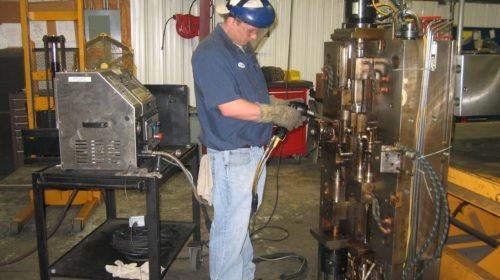THE SITUATION
The Geiger Group is made up of Hans Geiger Spritzgießtechnik GmbH – located in Franken – Hans Geiger Formenbau GmbH – located in Franconian Nürnberg – and HG Geiger Kunststofftechnik GmbH – located in Hilpoltstein. The company was founded in 1961 as a mold designing company by Hans Geiger and in 1968, injection molding was added. Today, the company specializes in producing complex components.
Clean mold cavities and vents are a major concern for plastic part manufacturers in maintaining today’s high quality standards – and is a main priority for the Geiger group, whose customers are electronics and automotive manufacturers.
THE PROBLEM
“Each product is only as good as its developing process,” said Hans Kolb, Process Engineer at Hans Geiger. “The quality and added value of a product is always a result of several, perfectly interlocking, individual steps – just one of the reasons why Geiger puts so much emphasis on the product development process. The cleaning of our tools is really important for our end product. The formation of coatings, due to the additives and flame retardants in plastics, has a direct influence on the quality of the products and the lifespan of tools.”
Therefore, fixed cycles have been established to ensure that the molds are well maintained and in flawless condition. Traditionally, molds have been cleaned by hand in the machine – or alternatively, the mold could be removed from the machine and then cleaned with chemicals, ultrasonic baths or by hand.
“If you need to clean 96 cavities by hand, it is not only time consuming but also hard to reach each crevice and angle, ” said Kolb. “Cleaning by hand in the machine was not very effective. Depending on the mold, 20 man-hours and up to 2 employees were needed. In addition, there was always the risk of damaging the mold, thereby reducing the lifespan of the equipment and tools needed to be replaced.”
Additional concerns were caused by beginning a new process, employee retention in the injection molding business and machine downtime. In addition to the cleaning process, an additional four hours (assembly and disassembly of the mold) needed to be added. It was not surprising that the Geiger Group was looking for a new cleaning process.
THE SOLUTION
Cold Jet’s dry ice cleaning system uses non-abrasive media in the form of recycled CO2 media (pellets or block) that won’t damage surfaces or equipment. The combination of dry ice blast cleaning’s kinetic energy and thermal effects break the connection between the dirt and surface, lifting away contaminants. Unlike blasting with other media, dry ice cleaning does not leave any secondary waste, as the dry ice pellets or particles sublimate – convert from solid to gas – upon impact. Dry ice cleaning is also safe and non-toxic, does not create downstream contamination, and reduces or eliminates employee exposure to dangerous chemical cleaning agents.
Kolb was familiar with dry ice blasting and it was clear that a block dry ice system was the right solution. A material supplier recommended Cold Jet’s i3 MicroClean® dry ice cleaning system and patented shaved MicroParticle technology.
By shaving dry ice media into the finest MicroParticles, more particles enter the air stream and strike the surface per second than traditional methods, quickly removing the contaminant and providing the fastest clean. The sugar-sized, shaved MicroParticles will enter the hardest-to-reach places and are small and delicate enough to pass through sensitive materials (like vents) for a thorough clean without worry of damaging the mold surface or changing dimensions – guaranteeing a consistent product quality.
After a demonstration of the i3 MicroClean, a rental system was offered and tested by the mold designing team. After a four week trial period, the results of the quality control were presented to the Geiger management team. The experience was so positive that they decided to purchase the rental system.
“This cleaning method is very effective to remove the contaminant from the tools and even helps when burnings occur,” said Kolb. “From certain coatings, we could reduce maintenance cycles up to 50%, therefore, the costs and downtime reduced considerably.”
Additional benefits for the Geiger group include productivity improvement, risk reduction and environmental initiative support. The cost factor was an essential part in their purchasing decision as well. Calculations for certain product groups were carried out to estimate the reduced effort. The company calculated that the investment will pay for itself in less than one year due to time savings and increased machine utilization.
A specific staff was assigned to review the usability. The mobile i3 MicroClean allowed the staff to go quickly through the production line and clean whenever and wherever it was necessary. The applicator’s ergonomic design and LED light provided optimal illumination of the surface being cleaned, increasing cleaning speed. Because of the 45°, 90° and 360° rotating nozzles available for the i3 MicroClean, it is now easy and effortless to clean hard to reach areas. Another benefit is the dry ice and the compressed air, which can be regulated individually and the settings can be exactly matched to the requirements. An average of one dry ice block is required for two tools. The maintenance staff is now better equipped to do preventative maintenance as less unplanned actions can occur. In addition, the mold does not often need disassembly for cleaning, reducing the risk of damaging the mold.
Kolb is a member of the Plastic Network in Franconia. Together with a Cold Jet employee, he carried out a presentation which resulted in great interest with the audience.
“Due to several advantages (quality, environment and cost) of Cold Jet dry ice blasting, we are holding a test phase at our sister plant Fa. Reiter, which manufactures mainly products for the medical industry.”




